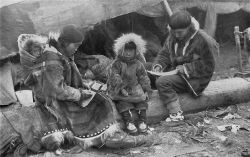|
|
| Line 1: |
Line 1: |
| | {{Main page article box| | | {{Main page article box| |
| | type=Featured| | | type=Featured| |
| − | title=Edward S. Curtis| | + | title=Family| |
| − | image_name=ECurtis.jpg| | + | image_name=Eskimo_Family_sm.jpg| |
| − | image_desc=Edward Sheriff Curtis| | + | image_desc=''An Eskimo Family'', by George R. King| |
| − | text='''Edward Sheriff Curtis''' (February 16, 1868 - October 19, 1952) was a [[photography|photographer]] of the [[American West]] and of [[Native Americans in the United States|Native American]] peoples. He was born at the time when the native peoples were in transition from a lifestyle where they were free to roam over whichever part of the continent they chose to a questionable future as the land was taken over by white settlers. | + | text=A '''family''' is a domestic group of people, or a number of domestic groups, typically affiliated by [[birth]] or [[marriage]], or by comparable legal relationships including [[adoption]]. There are a number of variations in the basic family structure. The [[nuclear family]] consists of husband and wife and their children, while the [[extended family]] includes grandparents, aunts, uncles, and cousins. Other family patterns include [[polygamy|polygamous]] (usually [[patriarchy|patriarchal]]) and single-parent families. |
| − | | + | }} |
| − | Invited to join [[anthropology|anthropological]] expeditions as a photographer of native tribes, Curtis was inspired to embark on the immense project that became his 20 volume work, ''The North American Indian''. Covering over 80 tribes and comprising over 40,000 photographic images, this monumental work was supported by [[J.P. Morgan]] and President [[Theodore Roosevelt]]. Although today Curtis is regarded as one of the greatest American art photographers, in his time his work was harshly criticized by scholars and the project was a financial disaster.
| |
| − | | |
| − | Nevertheless, Curtis' work is an incredible record of Native American people, of their strength and traditional lifestyles before the white men came. His vision was affected by the times, which viewed the native peoples as a "vanishing race," and Curtis sought to record their ways before they completely vanished, using whatever remained of the old ways and people to do so. Curtis paid people to recreate scenes, and manipulated images to produce the effects he desired. He did not see how these people were to survive under the rule of the Euro-Americans, and so he did not record those efforts. In fact, their traditional lifestyles could not continue, and it was those that Curtis sought to document. Given the tragic history that ensued for these peoples, his work stands as a testament to their strength, pride, honor, beauty, and diversity, a record that can help their descendants regain places of pride in the world and also help others to better appreciate their true value.}}
| |

An Eskimo Family, by George R. King
A
family is a domestic group of people, or a number of domestic groups, typically affiliated by birth or
marriage, or by comparable legal relationships including
adoption. There are a number of variations in the basic family structure. The
nuclear family consists of husband and wife and their children, while the
extended family includes grandparents, aunts, uncles, and cousins. Other family patterns include
polygamous (usually
patriarchal) and single-parent families.
